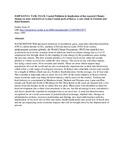| dc.description.abstract | BACKGROUND
With increased emissions of greenhouse gases, especially chlorofluorocarbons (CFCs) carbon dioxide (CO2), methane (CHJ and nitrous oxide (N3O) from various anthropogenic activities globally, the World Climate Programme, (WCP) has modelled two accelerated sea level rise scenarios both of which are based on climate change due to a 4.5°C temperature rise brought about by the trapping of solar energy by the greenhouse gases during the next one century.
The first scenario predicts a 0.3 metre sea level rise while the second predicts a 1 metre sea level rise within the next century. The sea level rise will affect mainly, low-lying coastal zones, Hver estuaries and islands. These are areas which support large populations all over the world and are also economically important due to their rich biodiversity which offers a wide range of ecological resources.
In Kenya, this vulnerable coastal zone extends for a length of 400km which runs in a North to South direction. On the average, it is 65 km wide. This coastline is important since it caters for over 50% of the tourist industry in Kenya with its major economic main stay being the hotel industry which caters for the tourists. Tourism and hotel industry is concentrated in Monibasa island, Malindi and Watamu area, Lamu and Pate islands and South and North of Monibasa for 601
Most hotels at the coast are situated only a few metres from the beaches in the so-called first low plots. These plots were identified as ideal for hotel development due to their close proximity to the sea, but this advantage is now considered a risk factor should the coastline be inundated due to sea level rise.
A need has therefore been recognised for an overall assessment of potential physical damage, implied risks, changes in administrative policies, resources partitioning and sharing, new legal and insurance policies, implications of sea level rise on flora and fauna, health implications and actual loss of beach area and the accompanying socio-economic impacts that will be brought about by the displacement of persons. | en |

